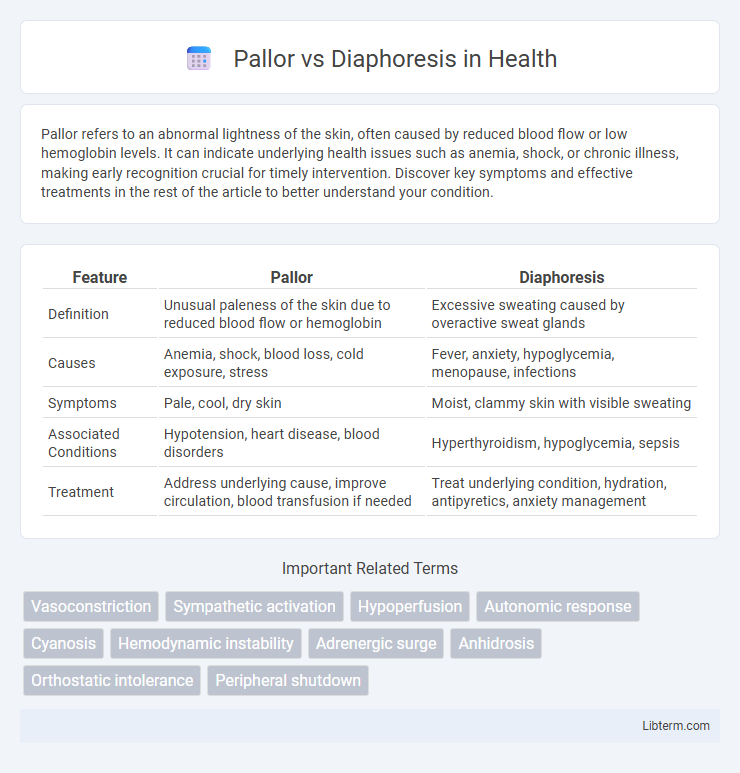Pallor refers to an abnormal lightness of the skin, often caused by reduced blood flow or low hemoglobin levels. It can indicate underlying health issues such as anemia, shock, or chronic illness, making early recognition crucial for timely intervention. Discover key symptoms and effective treatments in the rest of the article to better understand your condition.
Table of Comparison
| Feature | Pallor | Diaphoresis |
|---|---|---|
| Definition | Unusual paleness of the skin due to reduced blood flow or hemoglobin | Excessive sweating caused by overactive sweat glands |
| Causes | Anemia, shock, blood loss, cold exposure, stress | Fever, anxiety, hypoglycemia, menopause, infections |
| Symptoms | Pale, cool, dry skin | Moist, clammy skin with visible sweating |
| Associated Conditions | Hypotension, heart disease, blood disorders | Hyperthyroidism, hypoglycemia, sepsis |
| Treatment | Address underlying cause, improve circulation, blood transfusion if needed | Treat underlying condition, hydration, antipyretics, anxiety management |
Understanding Pallor: Definition and Causes
Pallor refers to an abnormal paleness of the skin, often caused by reduced blood flow or decreased oxygenation in the dermal capillaries. Common causes include anemia, shock, peripheral vasoconstriction, and chronic illnesses that impair circulation or hemoglobin levels. Recognizing pallor is essential in clinical diagnosis as it signals underlying conditions like acute blood loss, cardiac issues, or systemic infections that require prompt medical attention.
Diaphoresis Explained: What It Means
Diaphoresis refers to excessive sweating that occurs as a physiological response to stress, fever, or medical conditions such as hyperthyroidism, heart attack, or hypoglycemia. It results from the activation of sweat glands by the sympathetic nervous system, aiding in thermoregulation and toxin elimination. Unlike pallor, which is characterized by pale or ashen skin due to reduced blood flow or anemia, diaphoresis manifests as moist, clammy skin and often signals an underlying health issue requiring medical attention.
Key Differences Between Pallor and Diaphoresis
Pallor is characterized by an abnormal paleness of the skin due to reduced blood flow or decreased red blood cell concentration, often signaling anemia, shock, or peripheral vasoconstriction. Diaphoresis involves excessive sweating triggered by stress, fever, or autonomic nervous system activation, commonly linked to conditions such as myocardial infarction or hypoglycemia. The key difference lies in pallor's presentation of diminished skin coloration versus diaphoresis' profuse sweat production, each reflecting distinct underlying pathophysiological mechanisms.
Common Medical Conditions Associated with Pallor
Pallor is commonly associated with anemia, peripheral vascular disease, and shock, all of which reduce blood flow or oxygen delivery to the skin, causing a pale appearance. Diaphoresis frequently occurs in conditions such as myocardial infarction, hypoglycemia, and hyperthyroidism, where increased sympathetic nervous system activity triggers excessive sweating. Identifying pallor in patients often indicates underlying systemic issues like blood loss or poor circulation requiring immediate clinical evaluation.
Health Issues Frequently Linked to Diaphoresis
Diaphoresis, or excessive sweating, is frequently linked to health issues such as hyperthyroidism, heart attacks, and infections like sepsis. It can also indicate hypoglycemia or anxiety disorders, signaling the body's stress response or metabolic imbalance. Unlike pallor, which primarily involves pale skin due to reduced blood flow, diaphoresis reflects autonomic nervous system activation related to underlying systemic conditions.
Diagnostic Approaches for Pallor and Diaphoresis
Diagnostic approaches for pallor involve assessing skin and mucous membrane color changes through physical examination and measuring hemoglobin levels to identify anemia or blood loss. Diaphoresis diagnosis includes monitoring excessive sweating patterns, evaluating autonomic nervous system function, and conducting laboratory tests to detect underlying infections, endocrine disorders, or cardiovascular conditions. Both conditions benefit from detailed patient history and targeted diagnostic tests such as complete blood count (CBC), thyroid function tests, and electrocardiograms (ECG) to determine the root cause.
Clinical Significance: When to Be Concerned
Pallor, characterized by an unusual paleness of the skin, often signals reduced blood flow or oxygenation and can indicate anemia, shock, or peripheral vascular disease. Diaphoresis, or excessive sweating, frequently accompanies acute conditions like myocardial infarction, hypoglycemia, or sepsis and serves as a critical clinical indicator of autonomic nervous system activation. Prompt recognition of pallor and diaphoresis in emergency settings is essential for diagnosing underlying life-threatening conditions and initiating timely interventions.
Management and Treatment Options
Management of pallor involves addressing underlying causes such as anemia or hypoxia through blood transfusions, iron supplements, or oxygen therapy tailored to patient needs. Diaphoresis treatment targets the root condition, ranging from controlling infections with antibiotics to managing cardiac issues using beta-blockers or nitrates. Symptomatic relief includes maintaining hydration, electrolyte balance, and monitoring vital signs to prevent complications.
Patient Assessment: Recognizing Both Symptoms
Pallor presents as an abnormal paleness of the skin, often signaling anemia, hypoxia, or shock, making it crucial for healthcare providers to assess skin tone and mucous membranes during patient examination. Diaphoresis involves excessive sweating and may indicate underlying conditions such as myocardial infarction, hypoglycemia, or infections; monitoring sweat patterns and related symptoms is vital in clinical evaluation. Recognizing and differentiating these symptoms through thorough patient assessment ensures timely diagnosis and appropriate intervention for conditions affecting cardiovascular and metabolic stability.
Prevention and Monitoring Strategies
Effective prevention and monitoring strategies for pallor and diaphoresis involve regular assessment of underlying causes such as anemia, cardiovascular conditions, or infections. Continuous monitoring of vital signs, skin color changes, and sweating patterns helps detect early warning signs, enabling timely intervention. Implementing lifestyle modifications, hydration management, and appropriate medical treatments reduces the risk and severity of these symptoms.
Pallor Infographic

 libterm.com
libterm.com